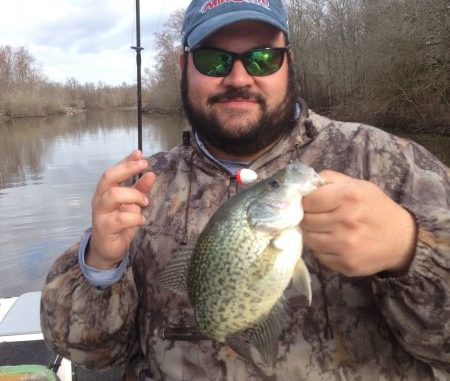
Work the banks in canals with cleaner water to catch more sac-a-lait, Macaluso says
While helping his fishing buddy Jeff Bruhl scout for a few bass hotspots in the Atchafalaya Basin on Friday, Chris Macaluso couldn’t help but wonder if the sac-a-lait were biting.
“I knew they had to be thinking about moving up to spawn, and I also knew the river was low,” he said. “So I had to think the sac-a-lait — around the Basin, anyway — that typically run up into flooded cover to spawn didn’t have any other choice but to hit the bank.”
Bruhl and Macaluso were fishing around Big Pigeon and Little Pigeon, including Bayou Cowan.
Once they switched from bass to sac-a-lait, Bruhl and Macaluso quickly put 25 fish in the boat.
“On Friday, the fish were around just about every little isolated grass patch, stump or downed tree,” Macaluso said. “Although I wouldn’t have called it a perfect day for catching sac-a-lait, they were really active for some reason.”
Just two days later, Macaluso returned with his father.
“Man, word must have gotten out because it looked like a Mardi Gras boat parade back in some of those canals,” he said.
That didn’t stop the father-and-son team from picking up an even better box of sac-a-lait. Macaluso believes their success on Sunday came from paying attention to a couple different variables.
“The first thing that helped us find the fish was looking for canals that had a little bit cleaner water than the bayou,” Macaluso went on. “But those canals had to have 6- to 8-feet of water in the middle, with 2-foot on the bank.”
Although anybody can find a certain depth canal with clearer water, not everybody is willing to put their baits where Joe and Chris Macaluso found the fish.
The sac-a-lait were definitely on the bank, but rather than being around isolated pieces of cover like they were Friday, Macaluso found the fish really tight on some of the nastiest cover he and his dad could find.
“There were a couple other boats around us that found the clear water but didn’t figure out where the fish were,” Macaluso said. “Either they didn’t know the fish were in the really thick stuff, or they just weren’t willing to put their baits in it.”
To catch fish, Macaluso and his dad fished jigs 1 foot under a sliding cork.
Although they tried several different colors, the only one the sac-a-lait would hit on Sunday was black and chartreuse.
“We just pitched our sliding corks up into the thick stuff,” Macaluso said. “If we had too much slack or pegged our corks, we stayed hung up.”
Basin sac-a-lait are known for bitting well all winter long, but they don’t think twice about moving up to spawn once the water temperature hits the mid 50s.
“When that water hits 54- or 55-degrees, they start feeling it,” Macaluso said. “The only problem this time of year is you usually can’t reach them when the river is high.
“But if it’s not high, they have no choice but to stop at the bank, where they become easy pickings.”
Not that he was trying to keep everybody off his fishing holes, but Macaluso wrapped up by saying that Big Pigeon and Little Pigeon weren’t the only spots to catch sac-a-lait now.
Anywhere you can find canals with clearer water than the bayous with that 6- to 8-foot deep water in the middle with 2 feet along the banks, you’re likely to find some fish.
“Find those canals with at least 54-degree water with some good cover,” Macaluso said, “and you should be set up nicely for great sac-a-lait fishing through the spawn — as long as the river doesn’t come up.”
Editor’s Note: This is the first in a series of articles by Chris Ginn on the current status of the crappie bite across the state. His next report will be on Lake D’Arbonne.


